12 Social Media Guidelines To Protect Your Brand’s Reputation
Social media guidelines for companies set clear expectations for appropriate social media activity so that employees feel comfortable engaging online and brands can protect their reputations and avoid legal disputes.
However, building your social media policy for employees can be challenging because most employee social media activity issues don’t stem from blatantly poor character (e.g., hate speech, bullying, racial slurs, etc.). Instead, PR crises and lawsuits usually arise from well-intended yet poorly handled situations, and you might not foresee these scenarios to include them in your social media policy examples.
For example, an employee may accidentally forget to cite a source, or they might click on a malicious link and disclose company information.
To protect the brand image and help your employees feel confident posting on social media, here’s an overview of the 12 social media guidelines for brands that we recommend.
What Are Social Media Guidelines?
Social media guidelines are rules outlined by a company that employees must abide by when participating on social media in the workplace.
Social media guidelines for business cover everything from branding rules aimed at maintaining the brand's reputation to legal guidance to avoid lawsuits and financial consequences.
Why Are Social Media Guidelines Important?
Social media guidelines ensure employees accurately represent the brand online to avoid negative PR, branding, and legal/financial consequences.
They also help employees feel more comfortable engaging online as social media guidelines clearly define acceptable social media behavior and state the consequences of breaking those rules.
12 Social Media Guidelines for Employees
The following 12 social media guidelines examples are suggestions to incorporate into your social media policy to help employees feel confident engaging online and protect your brand.
1. Follow the Code of Conduct
Your brand probably already has a code of conduct that outlines basic behavior expectations regarding topics like:
- Harassment.
- Violence.
- Hate Speech.
- Racism and Inclusivity.
- Profanity.
Remind employees that these rules apply to their personal and professional social media accounts, and outline the consequences of failing to abide by these standards.
If you haven't created a code of conduct, here are a few examples you can use for inspiration.
It's also important to inform employees how they can seek support if they are a victim of any bullying. If people try to handle a messy situation on their own by responding online, the issue can quickly escalate into an argument that subjects both the provoker and victim to disciplinary action as well.
To prevent this, outline in your social media guidelines that employees should alert a manager, a human resources staff member, and/or a member of the social media team of the instance.
Depending on the gravity of the situation, you can also offer counseling and other support to help employees.
2. Avoid Disclosing Confidential Company Information
Most employees don't intentionally disclose confidential information, and they may not realize that the content they share is confidential.
Highlight some of the basic social confidential company metrics that can never be disclosed, like:
- Revenue.
- Clients.
- Partnerships.
- Investments.
- Employee Records.
In addition to the metrics above, remind employees to avoid sharing confidential upcoming announcements like funding activity and product launches. They may simply forget and let it slip on social media.
3. Prioritize Inclusivity
Employees may not intentionally alienate people, but as social standards continue to evolve, they may accidentally make a remark that leaves others feeling uncomfortable.
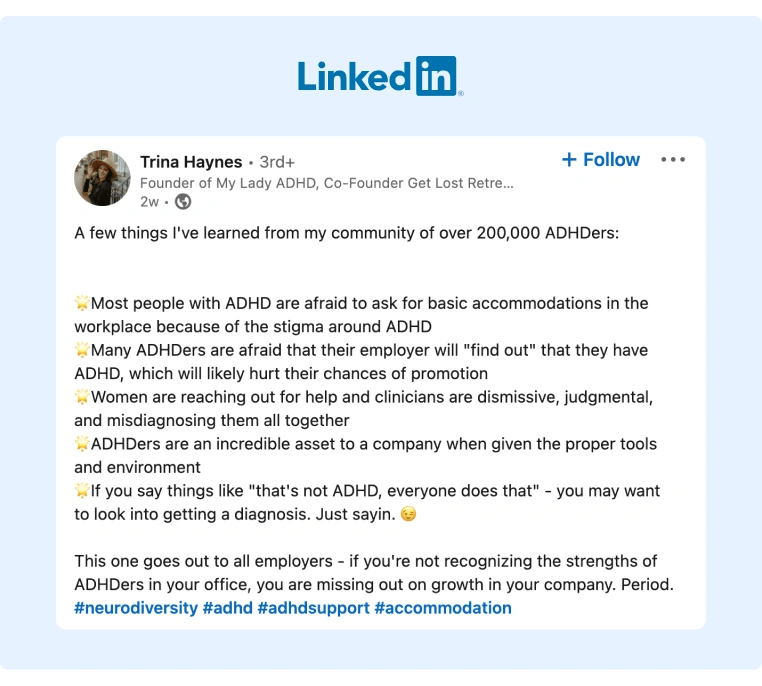
To prevent these situations, here are a few basic inclusivity guidelines you can include in your social media strategy:
- Recognize people's preferred pronouns (he, she, her, him, they, theirs, etc.) and avoid assumptions.
- Use emojis that are not gender-specific.
- Report any comments that make you feel uncomfortable.
- Respect people learning another language. Use simple language, and only correct them if they ask to be corrected.
- Avoid using inside jokes designed to alienate co-workers.
- Make text accessible and avoid any comments targeting someone's disabilities.
- Avoid remarks regarding someone's race, religion, or family.
In addition to outlining anti-inclusive content, state your company's policy on supporting anti-inclusive groups. For example, you may prohibit employees from posting content about those specific groups.
4. Respect Intellectual Property
If employees accidentally share intellectual property without permission from the owner (especially without giving credit), they could sue your company for thousands or even millions of dollars. It could also create a negative PR crisis that damages your brand's credibility.
Most employees simply don't realize what they're doing, so remind them that examples of intellectual property include:
- Data.
- Quotes.
- Graphics/Charts.
- Images.
- Examples.
- Case Studies.
5. Take Cyber Safety Into Consideration
In 2021, 74% of organizations claimed they experienced a social media cyber attack, and employees are often the primary targets to infiltrate a company's data.
To protect your company and employees from cyber attackers, include these basic rules in your social media guidelines for employees examples:
-
Never provide any company or employee information.
-
Avoid opening links from unknown senders.
-
Double-check the validity of any organization before engaging.
-
Avoid participating in giveaways or contests – especially from sources that aren't known or verified.
You can also ask employees to take the following four proactive approaches to safeguard their social accounts from cyber threats:
-
Use a strong password and change it every few months.
-
Use multi-factor authentication.
-
Avoid using social media accounts to log into third-party websites.
-
Connect to a secure network whenever possible.
It's also a good idea to have cybersecurity training for employees when you onboard them.
6. Disclose Company Association
According to the Federal Trade Commission, employees must disclose that they are affiliated with your company when they make a social media post on behalf of the company’s interests. This disclosure must be made directly on the relevant post – not just the employee’s social bio.
On the other hand, if employees are not posting on behalf of the company, you may want employees to explicitly state that all opinions are their own and do not reflect the company’s official viewpoint. You can ask employees to add this disclaimer to their bio or on the specific posts they create.
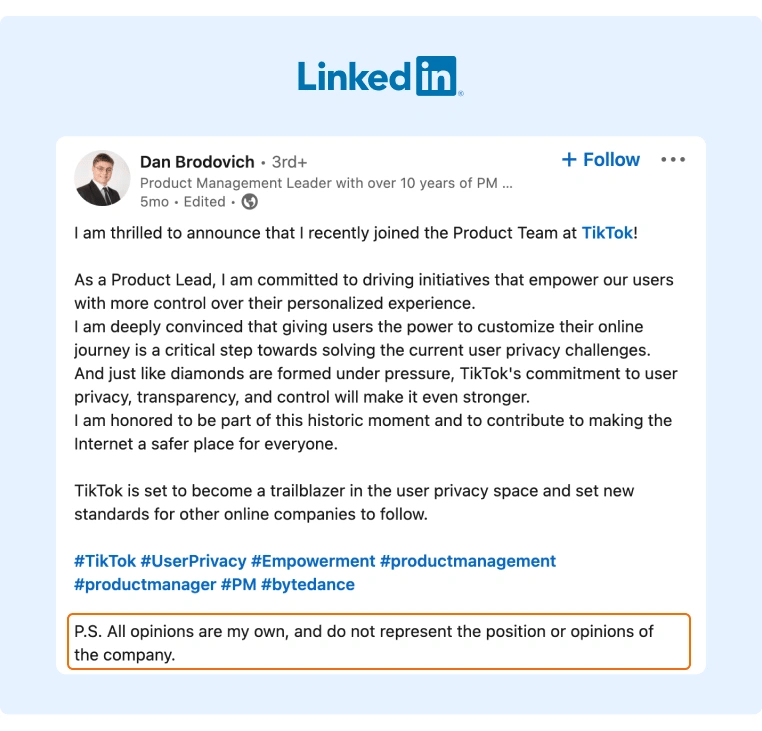
Source: Dan Brodovich
While employees must obey the general code of conduct, regardless of whether or not they're posting content on behalf of the company, adding a disclaimer can help your brand avoid controversial situations.
7. Avoid Conflicts of Interest
First, give employees a list of who your competitors are and then clearly communicate what employees may and may not say regarding competitors.
For example, explicitly state your stance on:
- Engaging with that competitor’s branded account.
- Engaging with other employees at the brand.
- Posting about that brand (consider your policies regarding both praising and bashing competitors).
- Mentioning other competitors' brand names on personal social media accounts.
Most employees don't intentionally praise or bash competitors, though there are scenarios where the best course of action is unclear.
For example, this study by SparkToro showed that the Ahrefs traffic metrics were relatively inaccurate in comparison to its competitors:
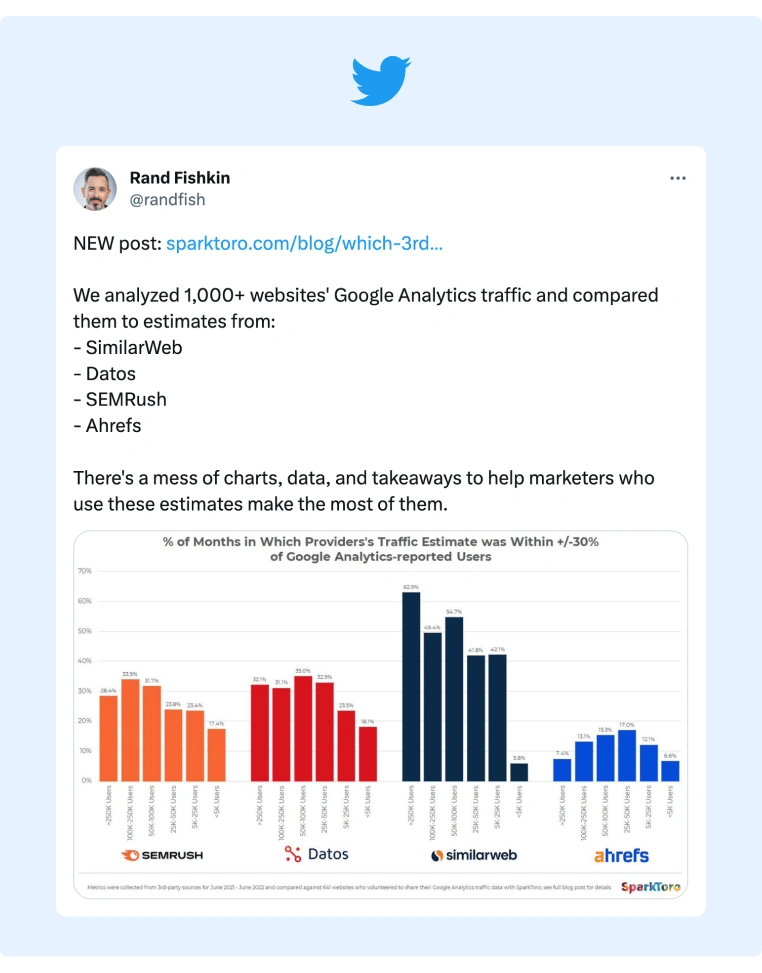
Source: Rand Fishkin
To handle the issue, CMO Tim Soulo responded with how Ahrefs handles traffic estimation and also linked to a blog post on the subject:

Source: Tim Soulo
This was an excellent response that received positive feedback from the audience.
To prevent a PR disaster, you can state in your social media guidelines that employees should simply alert a member of the social media team when a competitor's post mentions your brand name, and then they can collaborate with an executive to handle the situation.
8. Respect Co-Workers’ Privacy
Many employees love friendly shout-outs from their co-workers, but there are also situations where a co-worker's well-intended post makes team members feel uncomfortable.
To prevent these situations and help employees always feel confident on social media, provide a list of specific "dos" and "don'ts."
Here's a sample list you can use.
Dos:
- Give props to team members in comments.
- Give occasional props to a team member in a professional post.
- Engage in thoughtful discussions.
- When in doubt, ask employees if it's okay to post that on social media.
Don'ts:
- Post photos of that person without their permission.
- Post overly excessive praise that can make them uncomfortable.
- Reveal any personal information that isn't publicly available without their permission.
- Post anything intended to embarrass employees.
9. Respond Appropriately to Argumentative Content
There’s a fine line between a constructive debate and argumentative content. Clearly define the differences between the two so that employees feel confident engaging in discussions online.
In general, a healthy debate provides thoughtful counterpoints to a statement, while an inappropriate argument targets someone personally.
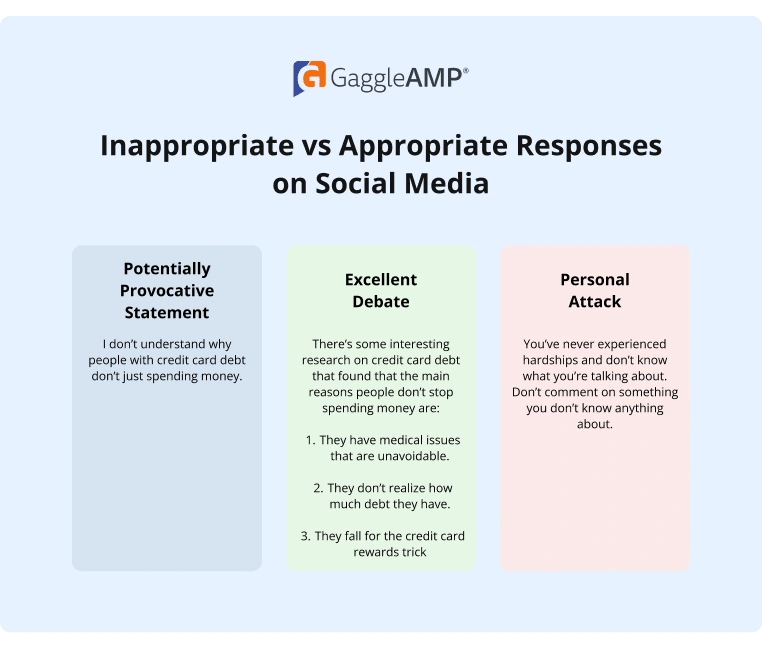
Remind employees that this rule also applies to their personal accounts. So, even if employees are just engaging on an informal social media site, their activity is still subject to company policy.
10. Legally Off-Limit Topics
Depending on your industry, there may be some topics that employees can’t legally provide advice on.
For example, if you’re a law firm, your employees may post content intended to be thought leadership content but accidentally provide unauthorized legal advice.
This can cause not only a PR disaster, but also create legal consequences for the company and damage the brand’s reputation and credibility.
As you’re onboarding employees, thoroughly outline topics that are off limits, and also tell them which topics they are allowed to discuss.
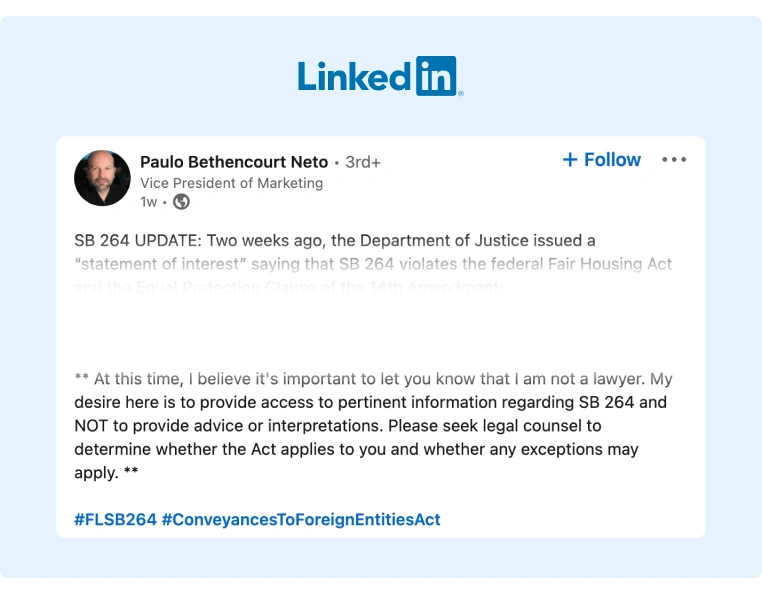
11. Posting Political Content and Misinformation
In many cases, employers can fire employees for political beliefs as political views aren't protected the same way that other attributes like gender, age, and race are protected.
For example, Jason Fried of Basecamp banned political talk at work in a controversial statement.
Outline what employees can and can't say regarding political parties they do or do not support, and clarify the consequences for failing to abide by those rules.
Misinformation is also a rising concern, so consider adding a point in your social media guidelines highlighting sources employees may not cite and company policy regarding publishing statements that are untrue or lack factual evidence.
12. When In Doubt – Just Ask
Most employees don't act inappropriately intentionally on social media, but there may be challenging situations that they simply don't know how to manage.
Above all else, encourage employees to reach out to their manager or the social media team if they're unsure of how to proceed with a particular issue.
If you want a sample social media policy, you can use this template and edit it as you wish.
How To Encourage Appropriate Social Media Engagement
Social media guidelines exist to help employees clearly understand what they should not post so that they can confidently publish relevant content. In fact, your brand will benefit if your employees have a strong social media presence and frequently discuss the brand's mission and latest updates.
In addition to providing a set of guidelines on behaviors to avoid, you should also help employees understand what they should post to help them build a personal brand.
Here's a list of "dos" that you can give to employees to encourage appropriate social media usage:
-
Post about aspects you enjoy about the brand, the culture, and work.
-
Post thought-leadership content on recent industry news.
-
Share information about personal accomplishments and updates.
-
Comment on co-workers' and branded content.
If you're still struggling to get employees to engage on social media, consider using an employee advocacy tool like GaggleAMP to help employees become comfortable on social media.
It allows you to assign specific engagement requests with detailed instructions to employees at scale so they never worry about saying the wrong thing.
Here's a brief overview of how it works:
Step 1: Select an Engagement Activity and Complete It With Detailed Instructions
GaggleAMP offers an engagement activity for all major social media platforms (LinkedIn, Twitter, Facebook, etc.), and you can customize it with a link to a specific post you want employees to engage with (e.g., a branded post, an executive's post, etc.) and even include guidelines on what they can say.
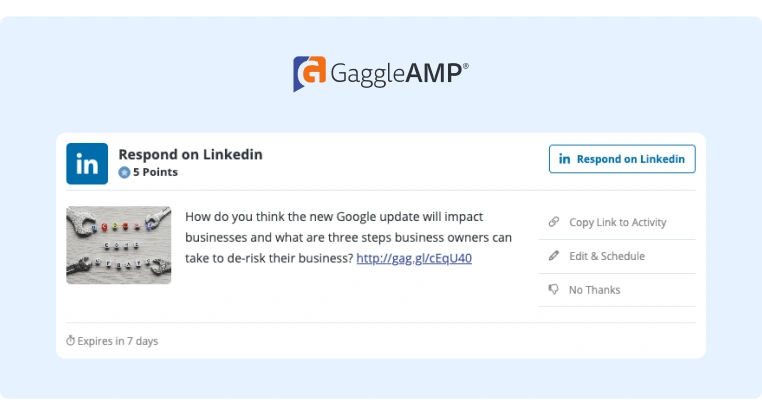
Providing specific details on what to say makes many employees feel more confident engaging on social media channels because they have specific instructions on what to say.
Step 2: Assign the Post To Specific Employees
Once you’ve filled out the engagement activity, you can assign it to a specific employee or a group of employees (e.g., the sales team).
Each employee then receives a notification that they have an engagement request, and they can click the link to view all requests in their personalized Gaggle.
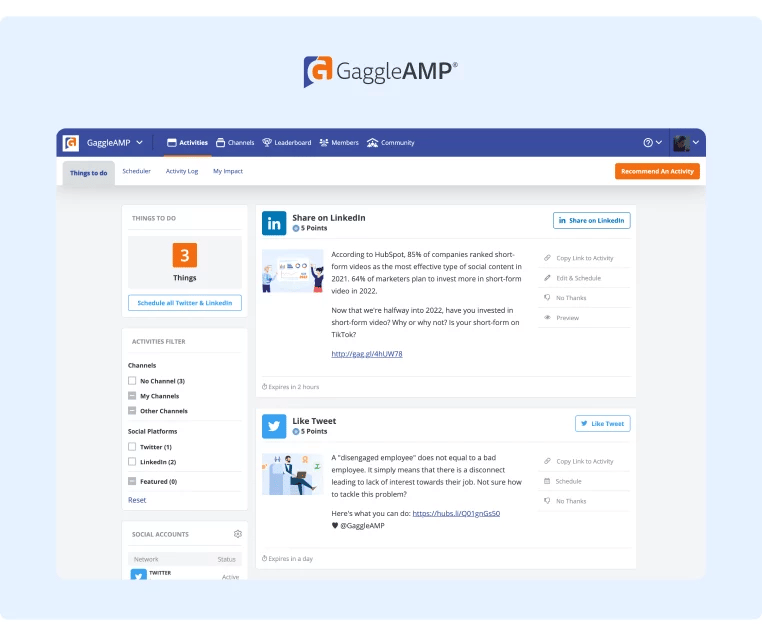
Step 3: Employees Complete the Engagement Requests and Schedule Them to Publish
Employees can complete each activity directly inside their Gaggle and then schedule it to publish later. This way, their content will go live throughout the week, yet they only have to dedicate a few minutes to content creation each week.
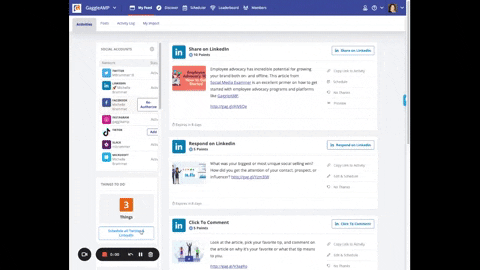
Level Up Your Social Media Game
Social media guidelines are like training wheels that give employees the basic rules they can follow to learn how to connect on social media. However, GaggleAMP gives them the tools they need to start posting their own content on social media.
This gives them the confidence to post social media content more regularly, which can ultimately help improve your brand's presence and thought leadership.
To learn more about GaggleAMP, check out the product page or schedule a demo today!










